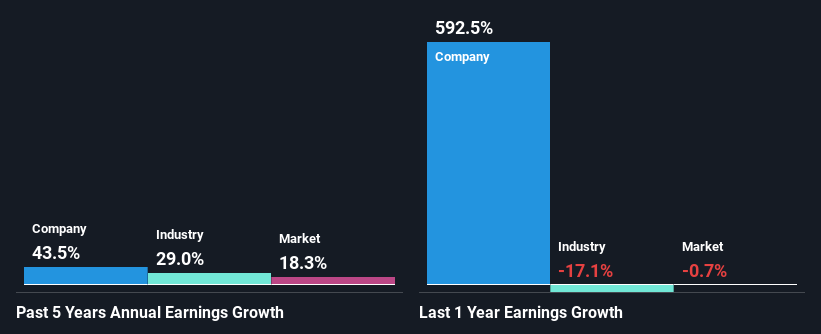Has Hudbay Minerals Inc.'s (TSE:HBM) Impressive Stock Performance Got Anything to Do With Its Fundamentals?
Hudbay Minerals (TSE:HBM) has had a great run on the share market with its stock up by a significant 80% over the last three months. We wonder if and what role the company's financials play in that price change as a company's long-term fundamentals usually dictate market outcomes. Particularly, we will be paying attention to Hudbay Minerals' ROE today.
Return on equity or ROE is an important factor to be considered by a shareholder because it tells them how effectively their capital is being reinvested. Simply put, it is used to assess the profitability of a company in relation to its equity capital.
View our latest analysis for Hudbay Minerals
How To Calculate Return On Equity?
The formula for return on equity is:
Return on Equity = Net Profit (from continuing operations) ÷ Shareholders' Equity
So, based on the above formula, the ROE for Hudbay Minerals is:
3.7% = US$83m ÷ US$2.2b (Based on the trailing twelve months to March 2024).
The 'return' is the income the business earned over the last year. That means that for every CA$1 worth of shareholders' equity, the company generated CA$0.04 in profit.
What Is The Relationship Between ROE And Earnings Growth?
Thus far, we have learned that ROE measures how efficiently a company is generating its profits. Depending on how much of these profits the company reinvests or "retains", and how effectively it does so, we are then able to assess a company’s earnings growth potential. Assuming everything else remains unchanged, the higher the ROE and profit retention, the higher the growth rate of a company compared to companies that don't necessarily bear these characteristics.
Hudbay Minerals' Earnings Growth And 3.7% ROE
It is hard to argue that Hudbay Minerals' ROE is much good in and of itself. Not just that, even compared to the industry average of 9.6%, the company's ROE is entirely unremarkable. Despite this, surprisingly, Hudbay Minerals saw an exceptional 44% net income growth over the past five years. We believe that there might be other aspects that are positively influencing the company's earnings growth. For example, it is possible that the company's management has made some good strategic decisions, or that the company has a low payout ratio.
We then compared Hudbay Minerals' net income growth with the industry and we're pleased to see that the company's growth figure is higher when compared with the industry which has a growth rate of 29% in the same 5-year period.
Earnings growth is a huge factor in stock valuation. It’s important for an investor to know whether the market has priced in the company's expected earnings growth (or decline). By doing so, they will have an idea if the stock is headed into clear blue waters or if swampy waters await. What is HBM worth today? The intrinsic value infographic in our free research report helps visualize whether HBM is currently mispriced by the market.
Is Hudbay Minerals Using Its Retained Earnings Effectively?
Hudbay Minerals' ' LTM (or last twelve month) payout ratio is on the lower side at 6.1% implying that it is retaining a higher percentage (94%) of its profits. So it seems like the management is reinvesting profits heavily to grow its business and this reflects in its earnings growth number.
Moreover, Hudbay Minerals is determined to keep sharing its profits with shareholders which we infer from its long history of paying a dividend for at least ten years. Our latest analyst data shows that the future payout ratio of the company is expected to drop to 2.4% over the next three years. As a result, the expected drop in Hudbay Minerals' payout ratio explains the anticipated rise in the company's future ROE to 12%, over the same period.
Conclusion
In total, it does look like Hudbay Minerals has some positive aspects to its business. Even in spite of the low rate of return, the company has posted impressive earnings growth as a result of reinvesting heavily into its business. Having said that, the company's earnings growth is expected to slow down, as forecasted in the current analyst estimates. To know more about the company's future earnings growth forecasts take a look at this free report on analyst forecasts for the company to find out more.
Have feedback on this article? Concerned about the content? Get in touch with us directly. Alternatively, email editorial-team (at) simplywallst.com.
This article by Simply Wall St is general in nature. We provide commentary based on historical data and analyst forecasts only using an unbiased methodology and our articles are not intended to be financial advice. It does not constitute a recommendation to buy or sell any stock, and does not take account of your objectives, or your financial situation. We aim to bring you long-term focused analysis driven by fundamental data. Note that our analysis may not factor in the latest price-sensitive company announcements or qualitative material. Simply Wall St has no position in any stocks mentioned.

 Yahoo Finance
Yahoo Finance 